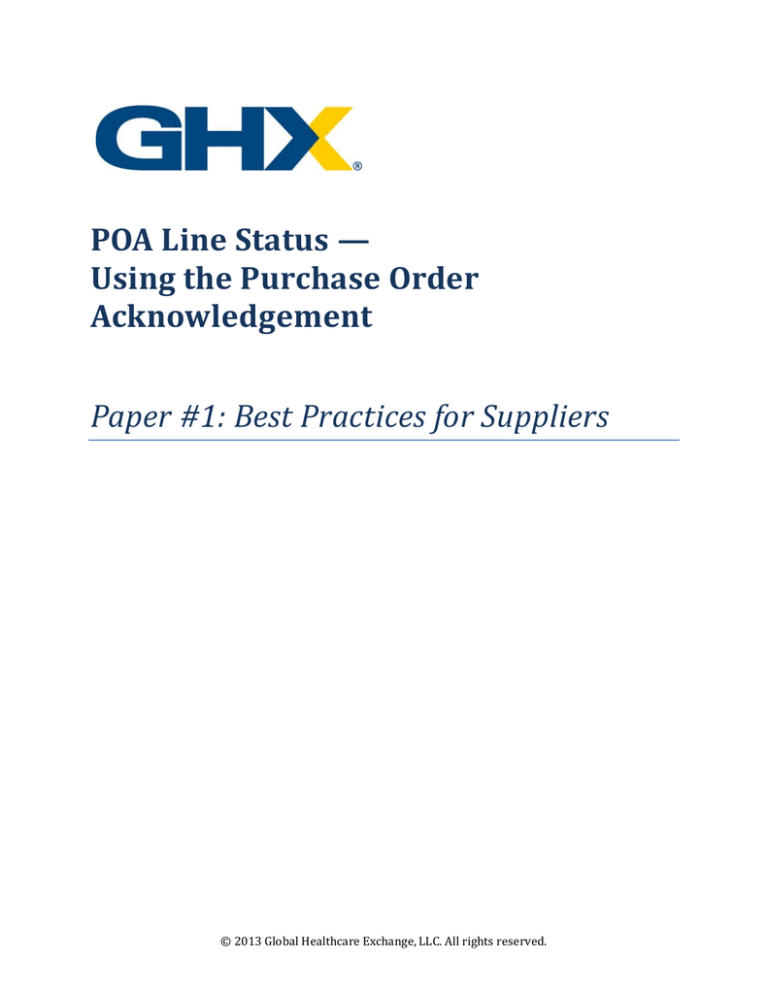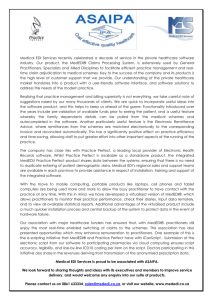
POA Line Status —
Using the Purchase Order
Acknowledgement
Paper #1: Best Practices for Suppliers
© 2013 Global Healthcare Exchange, LLC. All rights reserved.
POA Line Status — Using the Purchase Order Acknowledgement
Paper #1: Best Practices for Suppliers
Introduction
Electronic data interchange (EDI) and its use as an electronic commerce standard have evolved
dramatically over the last 20+ years, with some of the greatest advancements coming in the last five to
ten. EDI versions and dictionaries now manage a broad scale of line item updates that cover the
spectrum of business process standards for supply chain management across the healthcare industry.
Demand for real time information is continually increasing, and the need for accurate and actionable
data is more critical to business than ever. Within the healthcare landscape, practices have evolved
beyond the original EDI status use cases, creating needs for multiple status codes relaying similar
information. Alternate codes arose for backorders and item changes, while other status codes are being
used to relay messages in a more implicit manner.
GHX has reviewed our customers’ use of line item status codes and is supporting the community by
grouping these codes into a best practice standard. Since 2001, the GHX Integration teams have been
working to drive best practices that help deliver a consistent customer experience across trading
partners.
This document supports that effort by providing a reference document for clear definition of EDI usage
as well as expectations for future business metrics and historical trends such as exception reporting, fill
rate, backorder rate, and Perfect Order indicators.
© 2013 Global Healthcare Exchange, LLC. All rights reserved.
POA Line Status — Using the Purchase Order Acknowledgement
Paper #1: Best Practices for Suppliers
Common Business Scenarios and Expected Supplier Response
The below use cases are broken into two sections: header and line level. References to specific EDI
codes refer to segments as defined by EDI specifications for versions 4010 and 6020. We will look at
three specific buckets for use and common grouping: accepted, backordered, and rejected.
Order Acknowledgement: Header Level Status
The BAK02 element contains the single code that most accurately identifies the status of all line items.
This code is then supplemented by line level ACK element codes contained within the ACK01 element at
the line level.
The most commonly used codes are outlined below. The RJ status should not be used unless all line
items are rejected within the body of the document. Likewise, the AK status should not be used unless
the entire order is being accepted.
AC
RJ
Acknowledge – With Detail and Change
Rejected – No Detail
These alternate accepted codes indicate additional context:
AK
AD
AE
Acknowledge – No Detail or Change
Acknowledge – With Detail, No Change
Acknowledge – With Exception Detail Only
Line Level Exception Status Handling
The ACK segment contains the single code that most accurately identifies the status of the specific line
item. Proper use of the element includes the status element and the corrected data within the
appropriate fields. Users should refer to the published EDI data specifications for the specific
requirements of segment formatting.
Accepted Line Items (with/without changes)
Accepted (def): In an ordering cycle where product is available, this describes the process where the
order will be automatically shipped to the party placing the order, unless canceled.
Accepted – With Changes (def): Line item is accepted as outlined above, but includes data that has
changed from the submitted purchase order.
© 2013 Global Healthcare Exchange, LLC. All rights reserved.
POA Line Status — Using the Purchase Order Acknowledgement
Paper #1: Best Practices for Suppliers
The below table outlines statuses considered to indicate a positive response for the purposes of
aggregating data and calculating exception rates. These status codes tell the user the line item will be
filled as requested, have exceptions that should be reviewed by the buyer organization for accuracy
(e.g., unit price, part number, etc.), or provide insight into the seller organization’s order processing to
indicate that an item is no longer available or is on hold.
Status
Definition
AA
Item Accepted - Order Forwarded to Alternate Supplier Location
AC
Item Accepted and Shipped
AR
Accepted Released For Shipment
AT
No Description Available
IA
Item Accepted
IC
Item Accepted - Changes Made
IE
Item Accepted - Price Pending
IF
Item on Hold, Incomplete Description
II
Item Invoiced
IM
Item Invoiced - Changes Made
IH
Item On Hold
IP
Item Accepted - Price Changed
IS
Item Accepted - Substitution Made
IW
Item on Hold-Waiver Required
NA
None
SC
Accepted and Shipped with Changes
IQ
Item Accepted - Quantity Changed
The many types of “accepted” statuses can relay other critical information as outlined in the following
table. These are examples and not inclusive of every scenario, but address the majority of updates that
require action by the buyer organization.
Incorrect Unit of Measure (UOM)
Status Used:
IC Item Accepted – Changes Made
Data Included:
Correct UOM, Updated Quantity
Incorrect Price
Status Used:
IP Item Accepted – Price Change
Data Included:
Corrected Price
© 2013 Global Healthcare Exchange, LLC. All rights reserved.
POA Line Status — Using the Purchase Order Acknowledgement
Paper #1: Best Practices for Suppliers
Item Substitution
Status Used:
IS Item Accepted – Substitution Made
Data Included:
Vendor Part Number, Associated UOM, Updated Quantity
Multiple Item Changes (e.g., incorrect UOM and incorrect price)
Status Used:
IC Item Accepted – Changes Made
Data Included:
Corrected UOM, Corrected Unit Price, Corrected Vendor Part
Number
Item Fulfilled from Alternate Site (e.g., alternate warehouse/supplier)
Status Used:
AA Item Accepted - Order Forwarded to Alternate Supplier
Location
Data Included:
Quantity
Backordered Items
Backorder (def): In an ordering cycle where product is unavailable, this describes the process where the
order will be held until available and automatically shipped to the party placing the order, unless
canceled. Backorders are typically communicated in response to specific lines of a purchase order that
are not shipped with the original order and can be communicated [in] a Purchase Order
Acknowledgment (855) or as appropriate.1
The most common status codes indicate that all, or some, of the line item quantity will not be delivered
by the requested date. The buyer organizations must then need to determine if the products will need
to be obtained from alternate sources, or if the delays are acceptable and will meet the needs of their
organization. The codes below create a neutral or negative exception to the line status creating an
actionable event for the buyer to review.
Status
1
Definition
BP
Item Accepted - Partial Shipment, Balance Backordered
IB
Item Backordered
SP
Item Accepted - Schedule Date Pending
Source: http://www.healthcaredistribution.org/ir_issues/pdfs/2012-04-18-ProductAvailabilityGuidelines.pdf
© 2013 Global Healthcare Exchange, LLC. All rights reserved.
POA Line Status — Using the Purchase Order Acknowledgement
Paper #1: Best Practices for Suppliers
The three backorder status codes have specific use cases and are used commonly throughout the
industry. Quantities and/or line items that are acknowledged with these codes are also supplemented
with additional elements to relay information relevant to that code.
Entire Line Item Backordered (opt: known delivery date)
Status Used:
IB Item Backordered
Data Included:
Quantity, Expected Delivery Date (optional)
Partially Backordered Line Item
Status Used:
BP Item Accepted – Partial Shipment, Balance Backordered
Data Included:
Quantity Backordered, Paired with Additional Segment with
Accepted Status and Quantity
Item Backordered – Unknown Expected Ship Date
Status Used:
SP Item Accepted – Schedule Date Pending
Data Included:
Quantity
Rejected Line Items
Rejected (def): In an ordering cycle, where product will not be fulfilled by the seller due to product
unavailability, discontinuation, invalid data, or other valid reasons.
The rejection status codes have specific use cases and are used commonly throughout the industry.
These statuses are the most commonly used and understood by GHX customers, and normally require
action by the buyer organization.
These codes create a negative exception in the calculations for exception management, and a neutral
exception on the fill rate, backorder rate, and Perfect Order indicators for the supplier community.
Status
Definition
ID
Item Deleted
IR
Item Rejected
R1
Item Rejected, Not a Contract Item
R2
Item Rejected, Invalid Item Product Number
R3
Item Rejected, Invalid Unit of Measure
R4
Item Rejected, Contract Item Not Available (Discontinued)
By definition, the status codes reflect the complete message, so no additional detail is required.
© 2013 Global Healthcare Exchange, LLC. All rights reserved.
POA Line Status — Using the Purchase Order Acknowledgement
Paper #1: Best Practices for Suppliers
Conclusion
EDI and its use as an electronic commerce standard have evolved dramatically over the last 20+ years,
with some of the greatest advancements coming in the last five to ten. The ability to respond to
purchase orders with detailed statuses allows for real time analytics that drive additional automation
and savings within the healthcare landscape.
By updating and enhancing the aggregate groupings over time, GHX and the industry can continue to
identify areas for improvement between trading partners and throughout the supply chain. Continuous
review of e-commerce practices drives more accurate data for scorecards, volume reporting, supply
chain trends, and overall commitment to the community to achieve the Perfect Order.
GHX is committed to reviewing and enhancing our calculations and analytics so we can provide our
customers with accurate data and performance information. This encourages the collaboration and
communication needed to achieve best practice levels for a more efficient, cost-effective healthcare
supply chain.
Sources and Additional Reference Material
EDI Minimum Data Requirements 4010 v38x, GHX
Gregg Starkel and Aaron Barrett, Supplier Integration, GHX
American National Standards Institute (ANSI) X12 EDI Standards
http://www.x12.org/
HDMA EDI Guideline for a Purchase Order Acknowledgment (855), Healthcare Distribution Organization
http://www.healthcaredistribution.org
HDMA Order to Cash Guidelines_01_12_2011, Healthcare Distribution Organization
http://www.healthcaredistribution.org
HCSCR - Healthcare Supply Chain Research
http://www.hcsupplychainresearch.org
© 2013 Global Healthcare Exchange, LLC. All rights reserved.





